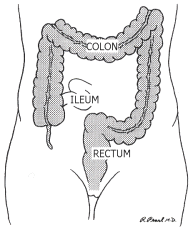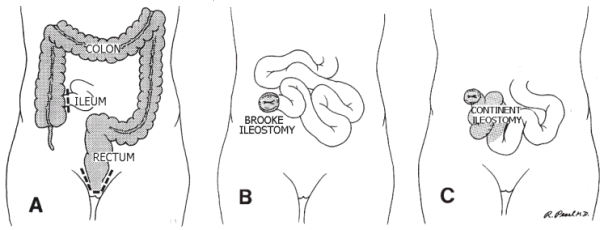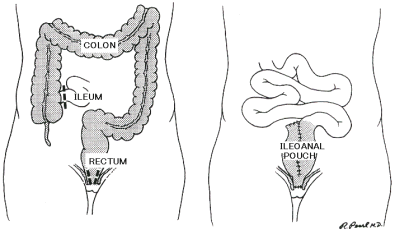|
||||||||||
|
|
||
¡ WHAT IS ULCERATIVE COLITIS? Ulcerative colitis is an inflammation of
the lining of the large bowel (colon). Symptoms
include rectal bleeding, diarrhea abdominal
cramps, weight loss and fever. In addition,
patients who have had extensive ulcerative
colitis for many years are at an increased
risk to develop large bowel cancer. The cause
of ulcerative colitis remains unknown. Ulcerative colitis is an inflammation of
the lining of the large bowel (colon). Symptoms
include rectal bleeding, diarrhea abdominal
cramps, weight loss and fever. In addition,
patients who have had extensive ulcerative
colitis for many years are at an increased
risk to develop large bowel cancer. The cause
of ulcerative colitis remains unknown. |
||
| ¥HOW IS ULCERATIVE COLITIS TREATED? Initial treatment of ulcerative colitis is medical, using antibiotics and anti-inflammatory medicating (drugs such as Alzulfidine, Prednisone, etc.). These are usually necessary on a long-term basis. Prednisone has significant side effects, and, therefore, it is usually used for short periods. gFlare-upsh of the disease can often be treated by increasing the dosage of medications or adding new medications such as 6-Mercaptopurine. Hospitalization may be necessary to put the bowel to rest. |
||
| ¥WHEN IS SURGERY NECESSARY? Surgery is indicated for patients who have life-threatening complications of inflammatory bowel diseases, such as massive bleeding, perforation or infection. It may also be necessary for those who have the chronic form of the disease, which fails medical therapy. It is important the patient be comfortable and that all reasonable medical therapy has been attempted prior to considering surgical therapy. In addition, patients who have long-standing ulcerative colitis and show cancer signs may be candidates for removal of the colon, because of the increase risk of developing cancer. More often, these patents are followed carefully with repeated colonoscopy and biopsy, and only if precancerous signs are identified is surgery recommended. |
||
| ¥WHAT OPERATIONS ARE AVAILABLE? Historically, the standard operation for ulcerative colitis has been removal of the entire colon, rectum, and anus. This operation is called a proctocolectomy (Illustration A) and may be performed in one or more stages. It cures the disease and removes all risk of developing cancer in the colon or rectum. However, this operation requires creation of a Brooke ileostomy (bringing the end of the remaining bowel through the abdomen wall, Illustration B) and chronic use of an appliance on the abdominal wall to collect waste from the bowel. The continent ileostomy (Illustration C) is similar to a Brooke ileostomy, but an internal reservoir is created. The bowel still comes through the abdominal wall, but an external appliance is not required. The internal reservoir is drained three to four times a day by inserting a tube into the reservoir. This option eliminates the risks of cancer and risks of recurrent persistent colitis but the internal reservoir may begin to leak and require another surgical procedure to revise the reservoir. |
||
 |
||
| Some patients may be treated by removal of
the colon, with preservation of the rectum
and anus. The small bowel can then be reconnected
to the rectum and continence preserved. This
avoids an ileostomy, but the risks of ongoing
active colitis, increased stool frequency,
urgency, and cancer in the retained rectum
remain. |
||
 |
||
| ¥ARE THERE OTHER SURGICAL ALTERNATIVES? The ileoanal procedure is the newest alternative for the management of ulcerative colitis. This procedure removes all of the colon and rectum, but preserves the anal canal. The rectum is replaced with small bowel, which is refashioned to form a samll pouch. Usually, a temporary ileostomy is created, but this is closed in several months. The pouch acts as a reservoir to help decrease the stool frequncy. This maintains a normal route of defecation, but most patients experience five to ten bowel movements per day. This operation all but eliminates the risk of recurrent ulcerative colitis and allows the patient to have a normal route of evacuation. Patients can develp inflammation of the pouch, which requires antibiotic treatment. In a small percentage of patients, the pouch fails to function properly and may have to be removed. If the pouch is removed, a permanent ileostomy will likely be necessary. |
||
 |
||
| ¥WHICH ALTERNATIVE IS PREFERED? It is important to recognize that none of these alternatives makes a patient with ulcerative colitis normal. Each alternative has perceivable advantages and disadvantages, which must be carefully understood by the patent prior to selecting the alternative which will allow the patent to pursue the highest quality of life. |
||
| give an authority GASCRS |
